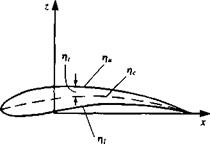THE BOUNDARY CONDITION ON THE WING
In order to satisfy boundary condition of Eq. (4.3), on the wing, the geometrical information about the shape of the solid boundaries is required. Let the wing solid surface be defined as
Z = Т}(х, У) (4.5)
and in the case of a wing with nonzero thickness two such functions will describe the upper (ru), and the lower (»/,) surfaces (Fig. 4.2). In order to find the normal to the wing surface, a function F{x, y, z) can be defined such that
F(x, y, z) = z- T}(x, y) = 0 (4.6)
and the outward normal on the wing upper surface is obtained by using Eq. (2.26):
![]() VF____ 1_ / Эту drj
VF____ 1_ / Эту drj
[VFpiVFi Э*’_3y ‘ /
whereas on the lower surface the outward normal is — n.
The velocity potential due to the free-stream flow can be obtained by using the solution of Eq. (3.52):
Ф., = U^x + Жс2 (4.8)
and, since Eq. (4.1) is linear, its solution can be divided into two separate parts:
Ф* = Ф + Ф„ (4.9)
Substituting Eqs. (4.7) and the derivatives of Eqs. (4.8) and (4.9) into the
 FIGURE 4.2
FIGURE 4.2
Definitions for wing thickness, upper and lower surfaces, and mean camberline at an arbitrary spanwise location y.
|
V3>* – n = УФ* |
boundary condition (Eq. (4.3)) requiring no flow through the wing’s solid boundaries results in
(4.10)
The intermediate result of this brief investigation is that the unknown is the perturbation potential Ф, which represents the velocity induced by the motion of the wing in a stationary frame of reference. Consequently the equation for the perturbation potential is
У2Ф = 0 (4.11)
and the boundary conditions on the wing surface are obtained by rearranging дФ/дг in Eq. (4.10):
![]()
![]()
![]() (4.12)
(4.12)
Now, introducing the classical small-disturbance approximation will allow us to further simplify this boundary condition. Assume
|
ЭФ |
dФ |
dф |
||
|
dx |
dy |
dz |
![]() G« ’ G – ’ G
G« ’ G – ’ G
Then, from the boundary condition of Eq. (4.12), the following restrictions on the geometry will follow:
This means that the wing must be thin compared to its chord. Also, near stagnation points and near the leading edge (where drj/dx is not small), the small perturbation assumption is not valid.
Accounting for the above assumptions and recalling that ~ Q^a and the boundary condition of Eq. (4.12) can be reduced to a much simpler form,
£<«.*,>-ft(fH (415)
It is consistent with the above approximation to also transfer the boundary conditions from the wing surface to the x-y plane. This is accomplished by a Taylor series expansion of the dependent variables, e. g.,
dФ dФ ді^Ф
~^(x, y,z = i]) = — (x, y,0) + T]-^(x, y,0) + O(t] ) (4.16)
Along with the above small-disturbance approximation, only the first term
from the expansion of Eq. (4.16) is used and then the first-order approximation of boundary condition, Eq. (4.12) (no products of small quantities are kept), becomes
f <*->■■ °)"Є"(!Н <4-i7>
A more precise treatment of the boundary conditions (for the two – dimensional airfoil problem) including proceeding to a higher-order approximation will be-considered in Chapter 7.











